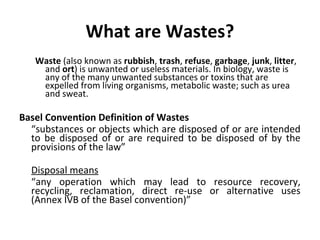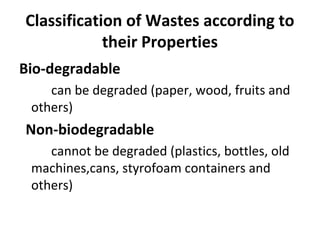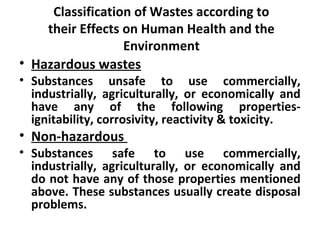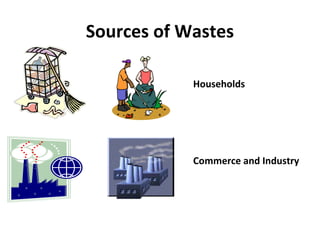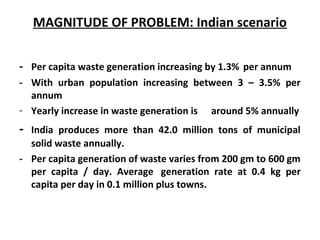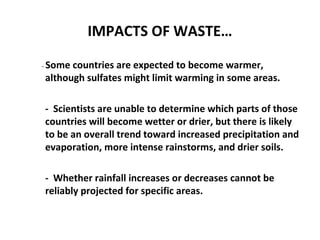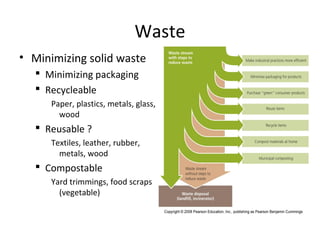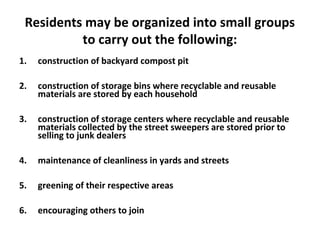Waste management
- 2. What are Wastes? Waste (also known as rubbish, trash, refuse, garbage, junk, litter, and ort) is unwanted or useless materials. In biology, waste is any of the many unwanted substances or toxins that are expelled from living organisms, metabolic waste; such as urea and sweat. Basel Convention Definition of Wastes “substances or objects which are disposed of or are intended to be disposed of or are required to be disposed of by the provisions of the law” Disposal means “any operation which may lead to resource recovery, recycling, reclamation, direct re-use or alternative uses (Annex IVB of the Basel convention)”
- 3. Basel Convention • The Basel Convention on the Control of Transboundary Movements of Hazardous Wastes and Their Disposal, usually known simply as Basel Convention, is an international treaty that was designed to reduce the movements of hazardous waste between nations, specially to prevent transfer of hazardous waste from developed to less developed countries (LDCs). It does not, however, address the movement of radioactive waste. The convention is also intended to minimize the amount and toxicity of wastes generated, to ensure their environmentally sound management as closely as possible to the source of generation, and to assist LDCs in environmentally sound management of the hazardous and other wastes they generate. • The Convention was opened for signature on 22nd March 1989, and entered into force on 5 May 1992.
- 4. The definition………… • Produced by the United Nations Statistics Division (U.N.S.D.): "Wastes are materials that are not prime products (that is products produced for the market) for which the generator has no further use in terms of his/her own purposes of production, transformation or consumption, and of which he/she wants to dispose. Wastes may be generated during the extraction of raw materials, the processing of raw materials into intermediate and final products, the consumption of final products, and other human activities. Residuals recycled or reused at the place of generation are excluded."
- 5. Kinds of Wastes Solid wastes: wastes in solid forms, domestic, commercial and industrial wastes Examples: plastics, styrofoam containers, bottles, cans, papers, scrap iron, and other trash Liquid Wastes: wastes in liquid form Examples: domestic washings, chemicals, oils, waste water from ponds, manufacturing industries and other sources
- 6. According to EPA regulations, SOLID WASTE is • Any garbage or refuse (Municipal Solid Waste) • Sludge from a wastewater treatment plant, water supply treatment plant, or air pollution control facility • Other discarded material • Solid, liquid, semi-solid, or contained gaseous material from industrial, commercial, mining, and agricultural operations, and from community activities http://www.epa.gov/epaoswer/osw/basifact.htm#solidwaste
- 7. Classification of Wastes according to their Properties Bio-degradable can be degraded (paper, wood, fruits and others) Non-biodegradable cannot be degraded (plastics, bottles, old machines,cans, styrofoam containers and others)
- 8. Classification of Wastes according to their Effects on Human Health and the Environment • Hazardous wastes • Substances unsafe to use commercially, industrially, agriculturally, or economically and have any of the following properties- ignitability, corrosivity, reactivity & toxicity. • Non-hazardous • Substances safe to use commercially, industrially, agriculturally, or economically and do not have any of those properties mentioned above. These substances usually create disposal problems.
- 9. Classification of wastes according to their origin and type • Municipal Solid wastes: Solid wastes that include household garbage, rubbish, construction & demolition debris, sanitation residues, packaging materials, trade refuges etc. are managed by any municipality. • Bio-medical wastes: Solid or liquid wastes including containers, intermediate or end products generated during diagnosis, treatment & research activities of medical sciences. • Industrial wastes: Liquid and solid wastes that are generated by manufacturing & processing units of various industries like chemical, petroleum, coal, metal gas, sanitary & paper etc. • Agricultural wastes: Wastes generated from farming activities. These substances are mostly biodegradable. • Fishery wastes: Wastes generated due to fishery activities. These are extensively found in coastal & estuarine areas. • Radioactive wastes: Waste containing radioactive materials. Usually these are byproducts of nuclear processes. Sometimes industries that are not directly involved in nuclear activities, may also produce some radioactive wastes, e.g. radio-isotopes, chemical sludge etc. • E-wastes: Electronic wastes generated from any modern establishments. They may be described as discarded electrical or electronic devices. Some electronic scrap components, such as CRTs, may contain contaminants such as Pb, Cd, Be or brominated flame retardants.
- 10. Sources of Wastes Households Commerce and Industry
- 11. MAGNITUDE OF PROBLEM: Indian scenario - Per capita waste generation increasing by 1.3% per annum - With urban population increasing between 3 – 3.5% per annum - Yearly increase in waste generation is around 5% annually - India produces more than 42.0 million tons of municipal solid waste annually. - Per capita generation of waste varies from 200 gm to 600 gm per capita / day. Average generation rate at 0.4 kg per capita per day in 0.1 million plus towns.
- 12. IMPACTS OF WASTE IF NOT MANAGED WISELY •Affects our health •Affects our socio-economic conditions •Affects our coastal and marine environment •Affects our climate •GHGs are accumulating in Earth’s atmosphere as a result of human activities, causing global mean surface air temperature and subsurface ocean temperature to rise. •Rising global temperatures are expected to raise sea levels and change precipitation and other local climate conditions. •Changing regional climates could alter forests, crop yields, and water supplies. •This could also affect human health, animals, and many types of ecosystems. •Deserts might expand into existing rangelands, and features of some of our national parks might be permanently altered.
- 13. IMPACTS OF WASTE… - Some countries are expected to become warmer, although sulfates might limit warming in some areas. - Scientists are unable to determine which parts of those countries will become wetter or drier, but there is likely to be an overall trend toward increased precipitation and evaporation, more intense rainstorms, and drier soils. - Whether rainfall increases or decreases cannot be reliably projected for specific areas.
- 14. Impacts of waste…. • Activities that have altered the chemical composition of the atmosphere: - Buildup of GHGs primarily carbon dioxide (CO2) methane (CH4), and nitrous oxide (N20). - C02 is released to the atmosphere by the burning of fossil fuels, wood and wood products, and solid waste. - CH4 is emitted from the decomposition of organic wastes in landfills, the raising of livestock, and the production and transport of coal, natural gas, and oil. - N02is emitted during agricultural and industrial activities, as well as during combustion of solid waste and fossil fuels. In 1977, the US emitted about one-fifth of total global GHGs.
- 15. SOURCES OF HUMAN EXPOSURES Exposures occurs through • Ingestion of contaminated water or food • Contact with disease vectors • Inhalation • Dermal
- 16. Points of contact • Soil adsorption, storage and biodegrading • Plant uptake • Ventilation • Runoff • Leaching • Insects, birds, rats, flies and animals • Direct dumping of untreated waste in seas, rivers and lakes results in the plants and animals that feed on it
- 17. Waste hierarchy Waste hierarchy refers to 3 Rs Reduce, Reuse, Recycle
- 18. Waste • Minimizing solid waste Minimizing packaging Recycleable Paper, plastics, metals, glass, wood Reusable ? Textiles, leather, rubber, metals, wood Compostable Yard trimmings, food scraps (vegetable)
- 19. “By recycling almost 8 million tons of metals (which includes aluminum, steel, and mixed metals), we eliminated greenhouse gas (GHG) emissions totaling more than 26 million metric tons of carbon dioxide equivalent (MMTCO2E). This is equivalent to removing more than 5 million cars from the road for one year.”
- 20. CATEGORIES OF WASTE DISPOSAL 1. DILUTE AND DISPERSE (ATTENUATION) Throw it in the river / lake / sea Burn it Basically this involves spreading trash thinly over a large area to minimize its impact Works for sewage, some waste chemicals, when land-disposal is not available Plastic in Pacific
- 21. 2. CONCENTRATE AND CONTAIN (ISOLATION) Waste dumps, landfills Historically, that’s how most of the solid waste gets treated
- 22. Useful options • Resource recovery • Composting • Vermicomposting • Energy recovery • Incineration • Pyrolysis • Gasification • Bio-methanation or anaerobic digestion
- 23. Impacts of waste on health Chemical poisoning through chemical inhalation Uncollected waste can obstruct the storm water runoff resulting in flood Low birth weight Cancer Congenital malformations Neurological disease
- 24. Impacts of waste on health • Nausea and vomiting • Increase in hospitalization of diabetic residents living near hazard waste sites. • Mercury toxicity from eating fish with high levels of mercury. Goorah, S., Esmyot, M., Boojhawon, R. (2009). The Health Impact of Nonhazardous Solid Waste Disposal in a Community: The case of the Mare Chicose Landfill in Mauritius. Journal of Environment Health, 72(1) 48- 54 Kouznetsova, M., Hauang, X., Ma, J., Lessner, L. & Carpenter, D. (2007). Increased Rate of Hospitalization for Diabetes and Residential Proximity of Hazardous waste Sites. Environmental Health Perspectives, 115(1)75-75 Barlaz, M., Kaplan, P., Ranjithan, S. & Rynk, R. (2003) Evaluating Environmental Impacts of solid Waste Management Alternatives. BioCycle, 52-56.
- 25. Effects of waste on animals and aquatics life • Increase in mercury level in fish due to disposal of mercury in the rivers. • Plastic found in oceans ingested by birds. • Resulted in high algal population in rivers and sea. • Degrades water and soil quality.
- 26. Impacts of waste on Environment • Waste breaks down in landfills to form methane, a potent greenhouse gas • Change in climate and destruction of ozone layer due to waste biodegradable • Littering, due to waste pollutions, illegal dumping, Leaching: is a process by which solid waste enter soil and ground water and contaminating them. • U.S. Environment Protection Agency (2009)
- 27. It is estimated that food wasted by the US and Europe could feed the world three times over. Food waste contributes to excess consumption of freshwater and fossil fuels which, along with methane and CO2 emissions from decomposing food, impacts global climate change. Every tonne of food waste prevented has the potential to save 4.2 tonnes of CO2 equivalent. If we all stop wasting food that could have been eaten, the CO2 impact would be the equivalent of taking one in four cars off the road.
- 28. WHAT SHOULD BE DONE • Reduce Waste - Reduce office paper waste by implementing a formal policy to duplex all draft reports and by making training manuals and personnel information available electronically. - Improve product design to use less materials. - Redesign packaging to eliminate excess material while maintaining strength. - Work with customers to design and implement a packaging return program. - Switch to reusable transport containers. - Purchase products in bulk.
- 29. WHAT SHOULD BE DONE Reuse - Reuse corrugated moving boxes internally. - Reuse office furniture and supplies, such as interoffice envelopes, file folders, and paper. - Use durable towels, tablecloths, napkins, dishes, cups, and glasses. - Use incoming packaging materials for outgoing shipments. - Encourage employees to reuse office materials rather than purchase new ones.
- 30. WHAT SHOULD BE DONE Donate/Exchange - old books - old clothes - old computers - excess building materials - old equipment to local organizations
- 31. WHAT SHOULD BE DONE Employee Education - Develop an “office recycling procedures” packet. - Send out recycling reminders to all employees including environmental articles. - Train employees on recycling practices prior to implementing recycling programs. - Conduct an ongoing training process as new technologies are introduced and new employees join the institution.
- 32. WHAT SHOULD BE DONE Employee Education - education campaign on waste management that includes an extensive internal web site, quarterly newsletters, daily bulletins, promotional signs and helpful reference labels within the campus of an institution.
- 33. WHAT SHOULD BE DONE Conduct outreach program adopting an ecologically sound waste management system which includes: • waste reduction • segregation at source • composting • recycling and re-use • more efficient collection • more environmentally sound disposal
- 34. Residents may be organized into small groups to carry out the following: 1. construction of backyard compost pit 2. construction of storage bins where recyclable and reusable materials are stored by each household 3. construction of storage centers where recyclable and reusable materials collected by the street sweepers are stored prior to selling to junk dealers 4. maintenance of cleanliness in yards and streets 5. greening of their respective areas 6. encouraging others to join
Editor's Notes
- Numerous epidemiology studies have been conducted to evaluate whether the health of people living near hazardous waste disposal sites is being adversely affected(Moeller, 20050.

